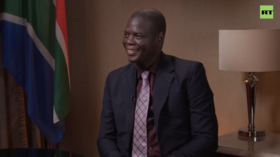Yellow slime mold caught feeding on its prey in fascinating timelapse (VIDEO)

Watching this yellow slime mold move on its prey is the most mesmerizing attack you’ll see today.
The fascinating jelly-like blob, has the wherewithal to navigate the elements and seek out its favourite food source: white mold.
Curious scientists at the New Jersey Institute of Technology investigated how exactly the single-celled brainless blob is able to survive in the wild by making smart decisions when looking for food.
The team conducted an timelapse experiment over a 24 to 48 hour period in which they filmed slime mold as it became hungry and spread out looking for sustenance. The process gave scientists an insight into how the mold deciphered, as a collective, which direction to hunt.
In reality, the mold only moves a few centimeters a day, but what scientists observed by speeding up the process was how the small hungry biomass sent out tentacle-like fingers of slime to explore its surroundings and search for food.
READ MORE: 3D bioprinter creates made-to-order body parts with living cells
Researchers found the slime branches communicated with each other every minute by using their pulsing mechanism, which triggers the mold to pump out in the direction of a “favorable environment”.
The institute has more than a year of experiments to conduct before it can release further results, but if initial testing has taught the team anything, it’s that intelligence doesn’t have to be complicated:
“Decision making doesn’t necessarily need complex communication mechanism, often just physics is enough,” said one of the study’s researchers Simon Garnier.
“I think what it makes you realize is how maybe intelligence is not that difficult, or maybe we should redefine what we mean by intelligence,” he added.













